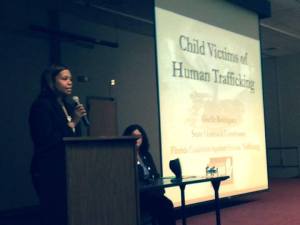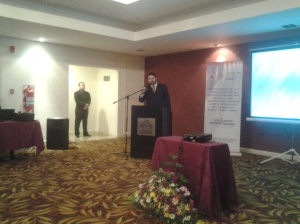On Tuesday, the U.S. House of Representatives passed a several bills addressing human trafficking. Politicians on both sides of the aisle have been patting themselves on the back and boasting about their good work here. However, the bills do very little to address ,labor trafficking, which comprises the majority of human trafficking within the U.S. , according to the U.S. State Department. For an organization who not only assist adult survivors of sex trafficking but one that also assists adult survivors of domestic servitude and labor trafficking, this is very discouraging. It is sad to see that both at the Federal and State level, forced labor continues to be swept under the rug. In recent years, the U.S and the state of Florida have not been in full compliance with the Trafficking Victims Protection Act 2000.
Of the 11 anti-trafficking bills passed by the House, few seem likely to actually assist victims. None of the bills really seem to address any of the root causes of human trafficking and does not appear to state anything that will actually help make a dent. However, the bills do help build a facade of hard-working legislators. Within the bills you will find important-sounding terms such as “Human Trafficking Detection Act of 2015” and “International Megan’s Law to Prevent Demand for Child Sex Trafficking.” They mandate reports! re classifications! distance-learning courses on preventing trafficking!
Here is a brief description of the individual bills:
H.R. 181, sponsored by Rep. Ted Poe (R-Tex.): Changes federal criminal code to subject anyone who “patronizes or solicits” commercial sex from someone under 18-years-old to a mandatory minimum federal prison sentence of 10 to 15 years (up to life). Raises the standard under which a defendant charged with soliciting commercial sex from a minor must prove they didn’t know the minor’s age, from “a preponderance of the evidence” to “clear and convincing evidence.”
The bill, known as the Justice for Victims of Trafficking Act of 2015, would also give more money to state and local law enforcement for anti-sex trafficking task forces, rescue missions, and prosecution units; set up special court programs that include “continuing judicial supervision of (people) who have been identified by a law enforcement … as a potential victim of child human trafficking, regardless of whether the victim has been charged with a crime related to human trafficking”; and create state-administered outpatient treatment centers for trafficking victims, among other things.
H.R. 515, sponsored by Rep. Christopher Smith (R-N.J.): Creates an “Angel Watch Center” within the Department of Homeland Security which will “facilitate the implementation of an international sex offender travel notification system in the United States and in other countries.” The center would notify foreign countries whenever a U.S. citizen convicted of a child-related sex crime was traveling there, as well as collect such information from other countries (and provide money to other countries to help them comply)
H.R. 159, from Rep. Erik Paulsen (R-Minn.): Allocates money for the development and creation of a “national human trafficking hotline.” Authorizes the Attorney General “to give preferential consideration in awarding Community Oriented Police Services grants” to applicants in states that treat minors engaged in prostitution as victims rather than criminals.
H.R. 460, sponsored by Rep. Mark Walker (R-N.C.): Implements a training program to help Transportation Security Administration (TSA) and Customs and Border Protection officials learn “how to effectively deter, detect, and disrupt human trafficking.”
H.R. 469, from Rep. Karen Bass (D-Calif.): Conditions eligibility to receive state grants for child abuse prevention on the state having a law or program dedicated to identifying and providing services for child sex-trafficking victims. Requires the HHS Secretary to report to Congress on child trafficking prevalence, state anti-trafficking practices, and “any barriers in federal laws or regulations that may prevent identification and assessment of children who are such victims.”
H.R. 514, from Rep. Christopher Smith (R-N.J.): Changes the status of the Office to Monitor and Combat Trafficking to a Bureau to Monitor and Combat Trafficking and changes the way we classify foreign countries on our “special watch list” for those not living up to U.S. trafficking-elimination standards.
H.R. 357, from Rep. Sean Maloney (D-N.Y.): Requires certain federal personnel to take “a distance learning course on trafficking-in-persons issues,” U.S. ambassadors to receive “specific trafficking-in-persons briefings,” and “at least annual reminders” to various federal personnel about “key problems, threats, methods, and warning signs of trafficking in persons.”
H.R. 468, from Rep. Joseph Heck (R-Nev.): Requires the Secretary of Health and Human Services (HHS) to give priority to staff training projects that relate to sex trafficking and authorizes the Secretary to make grants to private nonprofit agencies providing services to “runaway and homeless, and street youth, who have been subjected to, or are at risk of being subjected to, sexual abuse, prostitution, or sexual exploitation.”
H.R. 246, from Rep. Joyce Beatty (D-Ohio): Changes the language the National Center for Missing and Exploited Children must use for its “cyber tipline” from “child prostitution” to “child sex trafficking, including child prostitution.”
H.R. 350, from Rep. Kristi Noem (R-S.D.): Requires the Inter-agency Task Force to Monitor and Combat Trafficking to survey “state activities to deter individuals from committing trafficking offenses,” review the “academic literature on deterring individuals from committing trafficking offenses” and identify “best practices and strategies.” Also requires the Government Accountability Office to report to Congress about trafficking issues and authorizes grants for programs that assist trafficking victims with housing.
H.R. 398, from Rep. Renee Ellmers (R-N.C.): Allocates funding for the development and dissemination of anti-trafficking training for health care professionals.














